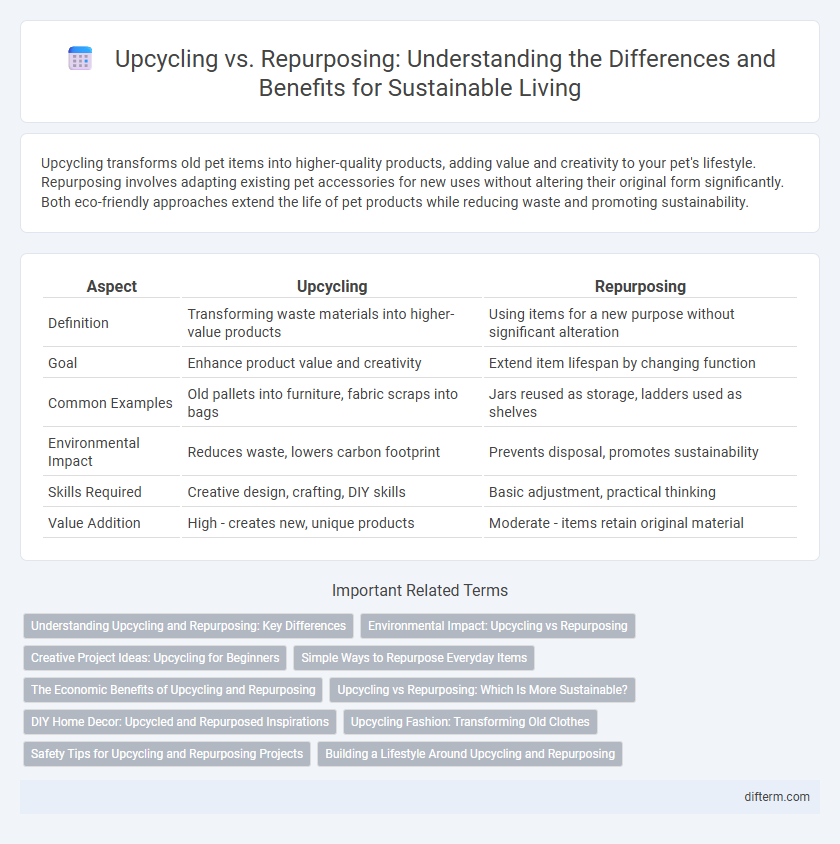Upcycling transforms old pet items into higher-quality products, adding value and creativity to your pet's lifestyle. Repurposing involves adapting existing pet accessories for new uses without altering their original form significantly. Both eco-friendly approaches extend the life of pet products while reducing waste and promoting sustainability.
Table of Comparison
| Aspect | Upcycling | Repurposing |
|---|---|---|
| Definition | Transforming waste materials into higher-value products | Using items for a new purpose without significant alteration |
| Goal | Enhance product value and creativity | Extend item lifespan by changing function |
| Common Examples | Old pallets into furniture, fabric scraps into bags | Jars reused as storage, ladders used as shelves |
| Environmental Impact | Reduces waste, lowers carbon footprint | Prevents disposal, promotes sustainability |
| Skills Required | Creative design, crafting, DIY skills | Basic adjustment, practical thinking |
| Value Addition | High - creates new, unique products | Moderate - items retain original material |
Understanding Upcycling and Repurposing: Key Differences
Upcycling involves transforming waste materials into products of higher value or quality, enhancing sustainability by reducing environmental impact. Repurposing, on the other hand, adapts existing items for new uses without significant alteration, extending the life cycle of materials. Both practices promote eco-conscious living but differ in their approach to resource utilization and creative innovation.
Environmental Impact: Upcycling vs Repurposing
Upcycling reduces environmental impact by transforming waste materials into higher-value products, conserving resources and minimizing landfill use. Repurposing extends the lifecycle of items by adapting them for new uses without significant alteration, which prevents waste but may not always enhance material value. Both practices significantly cut down on carbon emissions compared to producing new goods, though upcycling often delivers greater resource efficiency through creative redesign.
Creative Project Ideas: Upcycling for Beginners
Upcycling for beginners transforms discarded materials into valuable items through creativity and hands-on projects, such as turning old jeans into stylish tote bags or glass jars into decorative lamps. Repurposing, by contrast, adapts existing objects for new uses without extensive alteration, like using wooden pallets as garden planters. Emphasizing upcycling not only reduces waste but also encourages unique, eco-friendly home decor and fashion innovations.
Simple Ways to Repurpose Everyday Items
Transforming everyday items through repurposing reduces waste and promotes sustainable living by giving objects a second life with new functions. Simple ways to repurpose common household items include turning glass jars into storage containers, old t-shirts into reusable shopping bags, and wooden pallets into furniture or garden planters. These easy, cost-effective practices support eco-friendly habits and creatively extend the lifecycle of materials.
The Economic Benefits of Upcycling and Repurposing
Upcycling and repurposing reduce waste management costs by diverting materials from landfills, saving households and businesses significant disposal fees. These practices create opportunities for small-scale entrepreneurship, lowering the need for raw materials and enabling affordable product creation with higher profit margins. By extending the lifecycle of items, upcycling and repurposing decrease consumer spending on new goods, promoting sustainable financial habits while supporting local economies.
Upcycling vs Repurposing: Which Is More Sustainable?
Upcycling transforms waste materials into higher-quality products, reducing landfill waste and conserving resources more effectively than repurposing, which often alters items for different uses without enhancing value. Studies show that upcycling can reduce carbon emissions by up to 30% compared to traditional recycling methods, making it a more sustainable choice. Choosing upcycling promotes a circular economy by extending product life cycles and minimizing environmental impact.
DIY Home Decor: Upcycled and Repurposed Inspirations
Upcycling transforms discarded materials into stylish DIY home decor, enhancing sustainability by increasing the value of old items through creative redesign. Repurposing involves adapting existing objects for new functions without significant alteration, offering practical and budget-friendly decor solutions. Both methods promote eco-friendly living by reducing waste and inspiring unique, personalized home environments.
Upcycling Fashion: Transforming Old Clothes
Upcycling fashion transforms old clothes into stylish, unique pieces by enhancing their design and quality rather than simply altering their use. This sustainable practice reduces textile waste and minimizes environmental impact while promoting creativity and individuality. Brands and DIY enthusiasts embrace upcycling to elevate discarded garments into high-value, trend-forward fashion statements.
Safety Tips for Upcycling and Repurposing Projects
When engaging in upcycling and repurposing projects, prioritize safety by using proper protective gear such as gloves and masks to prevent exposure to harmful chemicals and dust. Ensure tools are in good condition and operate them according to manufacturer instructions to avoid accidents. Work in a well-ventilated area to reduce inhalation of fumes, and thoroughly clean all materials to eliminate toxins or contaminants before use.
Building a Lifestyle Around Upcycling and Repurposing
Building a lifestyle around upcycling and repurposing transforms waste into valuable, sustainable resources, reducing environmental impact while fostering creativity. Incorporating these practices encourages mindful consumption and supports eco-friendly habits by giving old items new life through innovative redesign and reuse. Engaging in community swaps, DIY projects, and sustainable shopping promotes a culture of resourcefulness and environmental responsibility.
Upcycling vs Repurposing Infographic

 difterm.com
difterm.com